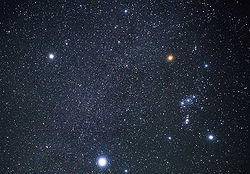Sirius

Sirius is the brightest star in the night sky. It is a binary star system in Canis Major, near Orion. It has an apparent magnitude of −1.46. The system is between 200 and 300 million years old.[1] It was originally composed of two stars: one was blue-white and one was white.
Sirius appears bright because of its intrinsic luminosity and its position (it is relatively close to Earth). At a distance of 2.6 parsecs (8.6 ly), the Sirius system is one of Earth's near neighbours.
The Egyptians called this star 'Sopdet'. They relied on it to predict when the flood season would start. Sirius is sometimes called the Dog Star. The phrase the dog days of summer means the hottest days of summer.
Sirius A
Sirius A is about twice as massive as the Sun and has an absolute magnitude of 1.42. It is 25 times more luminous than the Sun,[1] but has a significantly lower luminosity than other bright stars such as Canopus or Rigel.
Sirius B
Originally, Sirius B had about five times the mass of the Sun.[1] and was a B-type star (roughly B4–5)[2] when it still was on the main sequence.
Sirius B used up its fuel and became a red giant. Then it shed its outer layers and collapsed into its present state as a white dwarf, about 120 million years ago. Its mass now is about the same as the Sun.
Sirius Media
Hubble Space Telescope image of Sirius A and Sirius B. The white dwarf can be seen to the lower left. The diffraction spikes and concentric rings are instrumental effects. Sirius B is approximately one thousand times fainter than Sirius A.
Twinkling of Sirius (apparent magnitude = −1.5) in the evening shortly before upper culmination on the southern meridian at a height of 20 degrees above the horizon. During 29 seconds Sirius moves on an arc of 7.5 minutes from the left to the right.
Sirius (bottom) and the constellation Orion (right). The three brightest stars in this image—Sirius, Betelgeuse (top right) and Procyon (top left)—form the Winter Triangle. The bright star at top center is Alhena, which forms a cross-shaped asterism with the Winter Triangle.
A Chandra X-ray Observatory image of the Sirius star system, where the spike-like pattern is due to the support structure for the transmission grating. The bright source is Sirius B. Credit: NASA/SAO/CXC
Relative sizes of local stars, incl. Sirius, the Sun and Jupiter (artist’s impression)
Related pages
References
- ↑ 1.0 1.1 1.2 Liebert, J.; et al. (2005). "The age and progenitor mass of Sirius B". The Astrophysical Journal. 630 (1): L69–L72. arXiv:astro-ph/0507523. Bibcode:2005ApJ...630L..69L. doi:10.1086/462419. S2CID 8792889.
- ↑ Liebert J. et al 2005. The age and progenitor mass of Sirius B. Astrophysical Journal 630 (1): L69–L72. [1]








